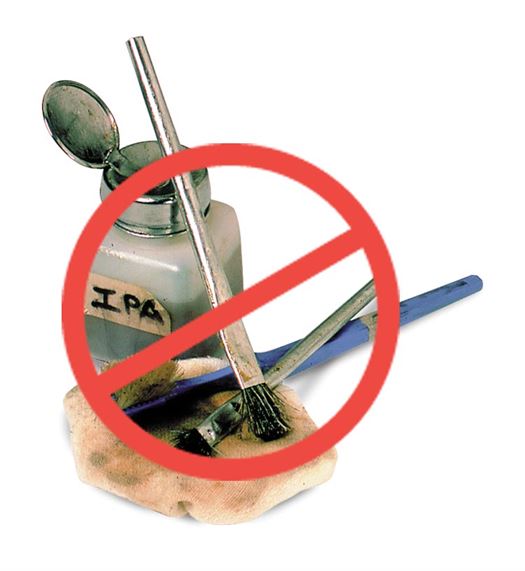Is Dip-and-Brush Cleaning Good for Cleaning Circuit Boards?
Why do engineers like dip-and-brush so much? Because they THINK it works fine and it appears to be inexpensive. Many don't know there are better alternatives to IPA and a brush. In fact, there are three things wrong with dip-and-brush cleaning: the process, the tool and the solvent. Let's take a look...
If You Can't Rinse, You Can't Clean
First, dip-and-brush cleaning isn't sufficient with today's modern electronics. In general, everything gets cleaned using the same four steps: Wet, Scrub, Rinse and Dry. But since dip-and-brush method doesn't enable techs to rinse the board, the contamination stays on the board. The techs can move it around, but most of the contamination stays on the PCB. As we like to say, techs can MOVE the residues but cannot REMOVE it. So they waste a lot of time, which is far more expensive than a TriggerGrip™ cleaning tool.
The Brush and the Bottle
It's very hard to get clean PCBs when you're using a dirty brush and dirty solvent. If the brush was cleaned after each use this might be an acceptable process. if the solvent was changed frequenrly and the bottle completely cleaned, that might be acceptable. But in truth, nobody does that. So the flux residues get re-deposited on the PCB. In December 2007, there was a very interesting technical note in Circuits Assembly Magazine by Mr. Terry Munson who bills himself as 'The Process Doctor.' Mr. Munson measured the contamination left on the boards after dip-and-brush cleaning using SIR testing, the most advanced form of board cleanliness testing. He concluded that rarely, if ever, would dip-and-brush cleaning achieve satisfactory results. It's simple. Most techs would love to have a better PCB cleaning tool, if one was available, and the Trigger Grip™ is the benchtop cleaning tool your techs need.
The Problems with IPA
Now, let's talk about the solvent. Alcohol has problem in general: it's flammable, it's hygroscopic, and it's smelly, and it's a weak cleaner. Technicians try to make IPA work. But they don't like it. They spend a lot of time (and your money) trying to clean with a old-fashioned solvent and an inappropriate process. No wonder they get inconsistent results. Most techs care about the following characteristics of their solvent, in this order of importance:
- Smell. No smell is better than a nice smell, which is better than a bad one
- Evaporation Speed. The faster the better
- Cleaning Strength. If it cleans fast and easily, that makes their job easier
- Safety. Nonflammable is better than flammable
Our recommendation: give everybody a can of the General Purpose Flux Remover (#MCC-FRC), a TriggerGrip™ cleaning tool and a Bench Mounting Kit. It's an inexpensive little system that works great, is priced right and solves all of the technician's worries.

